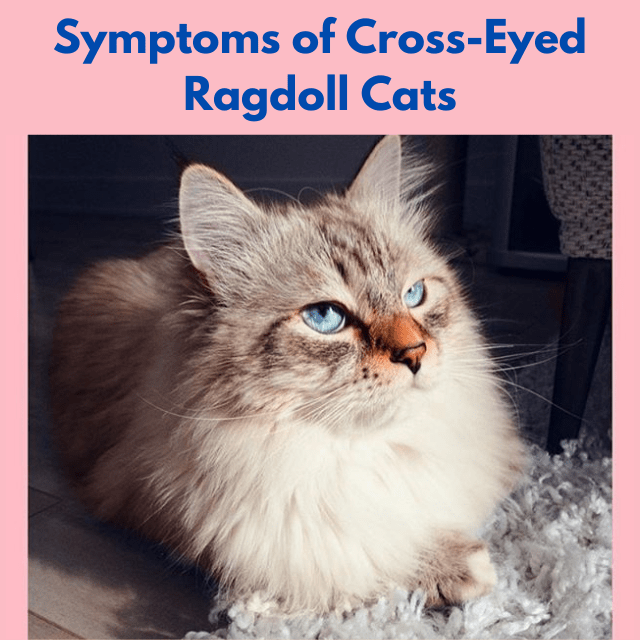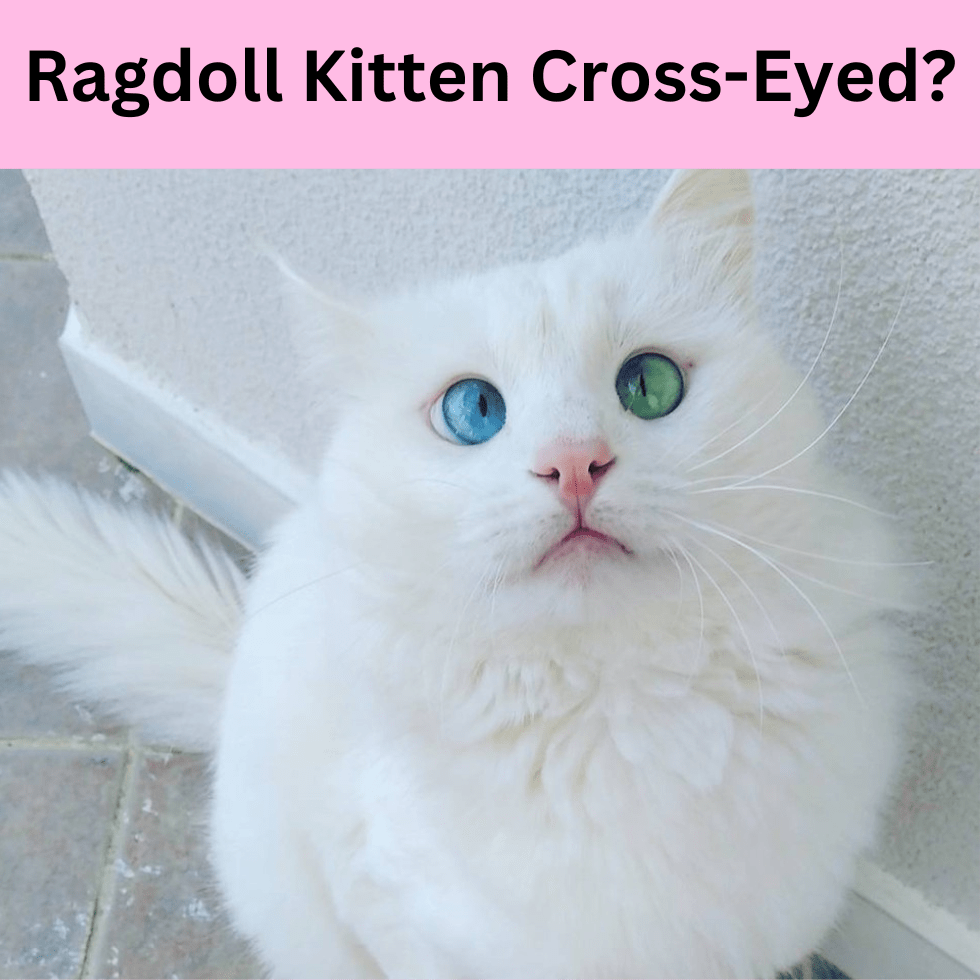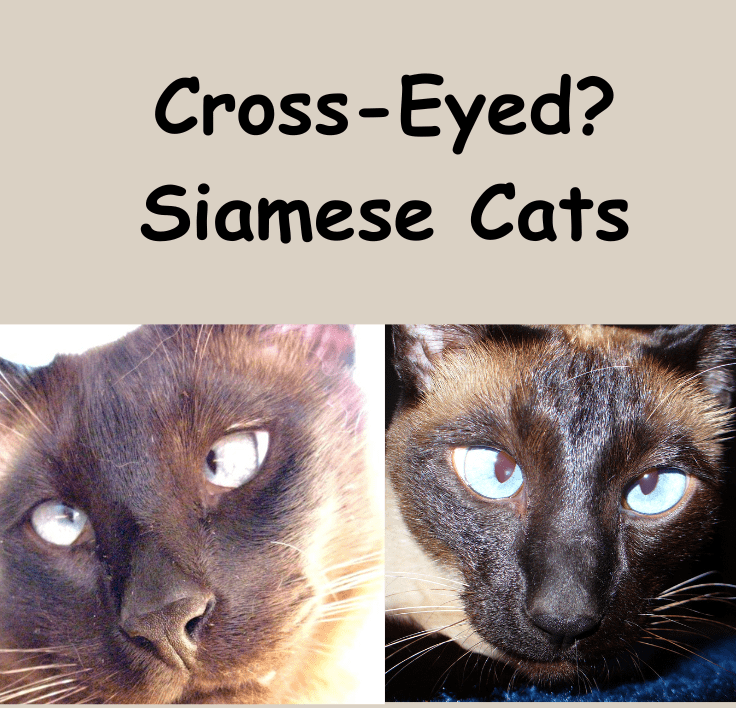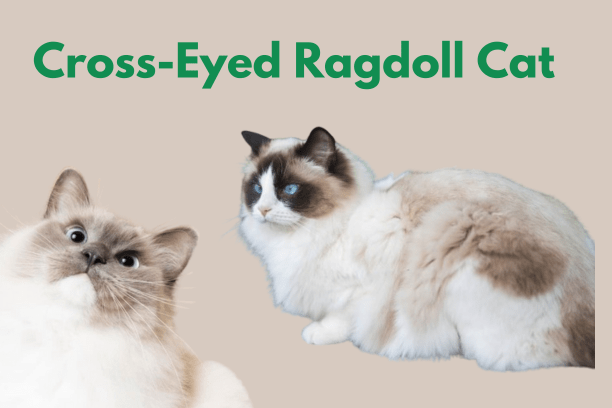Cross eyed ragdoll cats are a fascinating and adorable phenomenon that many cat lovers may not be aware of. Ragdoll cats are a breed of domestic cats that are known for their blue eyes, fluffy coats, and docile personalities.
They are often called “puppy cats” because they like to follow their owners around and cuddle with them. However, some ragdoll cats have a unique trait that makes them stand out from the rest: they are cross-eyed.
This means that their eyes are not aligned properly and point in different directions. In this article, we will explore the causes, symptoms, diagnosis, and treatment of cross-eyed ragdoll cats, and how they can still live a happy and healthy life with proper care and attention.
Should I be concerned if my ragdoll is cross eyed?
Cross-eyed or strabismus is a condition that causes the eyes of a cat to be misaligned. It can affect one or both eyes, and it can be either congenital (present at birth) or acquired (developed later in life).
Is Ragdoll cross-eyed?it is not uncommon in ragdoll cats, especially those with pointed color patterns, such as Siamese, Persian, and Himalayan cats. It is a genetic trait that does not usually affect the cat’s quality of life or vision, and they can adapt well to their condition.
However, if your ragdoll cat becomes cross-eyed all of a sudden, you should be concerned, as it may indicate a serious underlying problem, such as injury, disease, or tumor. In that case, you should take your cat to the vet for an examination and treatment.
Contents
- 1 Is it common for Ragdoll cats to be cross-eyed?
- 2 Causes of Cross-Eyed Ragdoll Cats
- 3 Symptoms of Cross-Eyed Ragdoll Cats
- 4 Diagnosis of Cross-Eyed Ragdoll Cats
- 5 Treatment of Cross-Eyed Ragdoll Cats
- 6 Are Ragdolls deaf?
- 7 Why is my Ragdoll kitten cross-eyed?
- 8 What breed of cat looks cross-eyed?
- 9 Conclusion
Is it common for Ragdoll cats to be cross-eyed?
Ragdoll cats are known for their stunning blue eyes, but some of them may also have a condition called cross-eyed or strabismus. This is when one or both eyes are not aligned properly, and they may point inward or outward.
Cross-eyed cats may look funny or cute, but is it common for Ragdoll cats to be cross-eyed? And should you be worried if your Ragdoll is cross-eyed?
Causes of Cross-Eyed Ragdoll Cats
Cross-eyed ragdoll cats have a condition called strabismus, which means that their eyes are not aligned properly and point in different directions. This can affect their ability to focus on objects, judge distances, or coordinate their eye movements.
Strabismus can be caused by genetic or environmental factors or a combination of both. One of the main genetic factors that can cause cross-eyed ragdoll cats is the pointed gene, which is responsible for the coloration of their fur and eyes.
The pointed gene is also linked to the albino gene, which can affect the development of the optic nerve and the muscles that control eye movement. Another genetic factor that can cause cross-eyed ragdoll cats is their Siamese ancestry, as Siamese cats are known to have a high incidence of strabismus.
Environmental factors that can cause cross-eyed ragdoll cats include injuries, infections, or diseases that can damage the eyes or the brain. A cross-eyed ragdoll cat may face some complications or risks due to their condition, such as reduced depth perception, impaired vision, or eye infections. However, these can be prevented or treated with proper care and attention.
Symptoms of Cross-Eyed Ragdoll Cats
The most obvious sign of cross-eyed ragdoll cats is their eye appearance. Their eyes may point inward (esotropia) or outward (exotropia), or appear to look in different directions (heterotropia).
The degree of misalignment may vary from mild to severe and may affect one or both eyes. Cross-eyed ragdoll cats may also have different eye behaviors than normal ragdoll cats. They may be more clumsy, timid, or curious, depending on how their vision is affected by their condition.
For example, they may bump into objects, shy away from sudden movements, or explore their surroundings more carefully. Some cross-eyed ragdoll cats may also tilt their head or squint their eyes to improve their focus. Here are some examples or photos of cross-eyed ragdoll cats that illustrate the symptoms:

- Uncoordinated eye movement
- Nystagmus (involuntary rapid eye movement)
- Lack of movement in one eye
- Pupil size difference
- Head tilting
- Turning to one side
- Weakness
- Difficulty walking
- Lethargy
- Seizures
- Loss of appetite
Diagnosis of Cross-Eyed Ragdoll Cats
If you suspect that your ragdoll cat is cross-eyed, you should take it to a veterinarian for a proper diagnosis. The vet will examine your cat’s eyes and perform some tests to determine the cause and severity of the condition. Some of the tests that the vet may use include:
Physical examination: The vet will look at your cat’s eyes and check for any signs of injury, infection, or inflammation. The vet will also observe your cat’s eye movements and behavior to assess its vision and coordination.
Eye tests: The vet may use some tools or techniques to measure your cat’s eye alignment, such as a penlight, a cover test, or a Hirschberg test. The vet may also check your cat’s eye pressure, pupil size, and reflexes to rule out any other eye problems.
Medical history: The vet may ask you some questions about your cat’s health and background, such as its age, breed, ancestry, symptoms, and medications. This can help the vet identify any genetic or environmental factors that may have contributed to your cat’s condition.
Cross-eyed ragdoll cats can be classified into two types: congenital and acquired. Congenital cross-eyed ragdoll cats are born with the condition, and it is usually caused by genetic factors.
Acquired cross-eyed ragdoll cats develop the condition later in life, and environmental factors usually cause it. The diagnosis of cross-eyed ragdoll cats may vary depending on the type, age, and condition of the cat. For example, congenital cross-eyed ragdoll cats may be easier to diagnose at a young age, while acquired cross-eyed ragdoll cats may require more tests to find the underlying cause.
Ragdoll cats are prone to some other eye problems that can affect their vision and health, such as cataracts, glaucoma, or uveitis. Cataracts are cloudy areas in the lens of the eye that can impair vision. Glaucoma is a condition where the eye pressure is too high, which can damage the optic nerve and cause blindness.
Uveitis is an inflammation of the uvea, which is the middle layer of the eye that contains blood vessels and pigment. These eye problems can have similar symptoms to cross-eyed ragdoll cats, such as squinting, redness, or discharge. The vet can rule out or confirm these eye problems by using some tests, such as an ophthalmoscope, a tonometer, or a slit lamp.
Treatment of Cross-Eyed Ragdoll Cats
Cross-eyed ragdoll cats may not need any treatment if their condition does not affect their quality of life or cause any health problems. However, some cases may require intervention by the owner, the vet, or both, depending on the severity and cause of the condition. Some of the options and benefits of treatment are:
- Surgery: This is a rare and invasive option that may be considered for severe cases of cross-eyed ragdoll cats, where the eye muscles are surgically adjusted to correct the alignment of the eyes. This can improve the vision and appearance of the cat, but it also carries some risks and complications, such as infection, bleeding, or recurrence of the condition.
- Medications: Some cross-eyed ragdoll cats may benefit from eye drops or ointments that can help lubricate, soothe, or prevent infection in the eyes. This can improve the comfort and health of the cat, but it also requires regular application and monitoring by the owner or the vet.
- Therapy: Some cross-eyed ragdoll cats may benefit from physical or behavioral therapy that can help stimulate, train, or enhance their vision and coordination. This can improve the confidence and agility of the cat, but it also requires time and patience from the owner or the vet.
Care of cross-eyed ragdoll cats
In addition to these treatments, cross-eyed ragdoll cats can also be cared for at home by the owner, who can provide a safe and stimulating environment for them. Some of the tips or advice for home care are:
- Provide a spacious and clutter-free area for the cat to move around and explore, without any sharp or dangerous objects that could injure them.
- Provide a variety of toys and games that can challenge and entertain the cat, such as puzzles, lasers, or feathers, that can encourage them to use their eyes and paws.
- Provide regular eye check-ups and visits to the vet, who can monitor the condition and health of the cat, and recommend any changes or adjustments in the treatment or care plan.
Are Ragdolls deaf?
Ragdolls are not deaf, contrary to a common myth. They have normal hearing ability, just like any other breed of cat. Their ears are fully functional and rely on their hearing to navigate their surroundings and communicate with their owners.
Ragdolls have not been found to have any genetic predisposition to deafness, unlike some other cat breeds. The misconception about Ragdolls being deaf likely stems from their calm nature and the fact that they can easily enter a state of deep relaxation when held or cuddled.
Ragdolls’ cross-eyed behavior is a characteristic of the breed, not a hearing impairment. Therefore, while ragdolls may appear insensitive to noises when they are in their “limp” condition, this is only a characteristic of their temperament.
Related Cat Breeds:
Why is my Ragdoll kitten cross-eyed?
Ragdoll kittens are adorable and fluffy, but some of them may also have a condition called cross-eyed or strabismus. This is when one or both eyes are not aligned properly, and they may point inward or outward.
Cross-eyed Ragdoll kittens may have different causes depending on whether they are born with the condition or develop it later in life. Some of the possible causes are:

- Genetics: Some Ragdoll kittens are born with a genetic trait that makes them prone to cross-eyed. This is more common in pointed cat breeds, such as Siamese, Persian, and Himalayan cats. It does not affect the kitten’s quality of life or vision, and they usually adapt well to their condition.
- Injury or disease: Some Ragdoll kittens may become cross-eyed due to an injury or disease that affects their eyes, muscles, nerves, or brain. This can happen at any age, and it may indicate a serious underlying problem. Some of the known causes of acquired cross-eyed in kittens are vestibular system disease, eye trauma, feline leukemia virus, nerve damage, hydrocephalus, inflammation, cancer, or tumor growth.
If you notice that your Ragdoll kitten is cross-eyed, you should take them to the vet for an examination. The vet will need your kitten’s medical history and will perform a physical, neurological, and ophthalmologic evaluation.
This can help to determine the cause and severity of the condition and rule out any other eye problems that may affect Ragdoll kittens, such as cataracts, glaucoma, or uveitis.
What breed of cat looks cross-eyed?
Cross-eyed, or strabismus, is a condition that causes the eyes of a cat to be misaligned. It can affect one or both eyes, and it can be either congenital (present at birth) or acquired (developed later in life).
Cross-eyed cats may look funny or cute, but they may also have some vision problems or underlying health issues. In this article, we will explore some of the breeds of cats that are more likely to look cross-eyed, and why this happens.
Siamese cats
Siamese cats are one of the most well-known breeds of cats that look cross-eyed. This is because they have a genetic trait that causes their eyes to point inward, or converge.
This trait is linked to the pointed gene, which gives them their distinctive color pattern and blue eyes. The pointed gene also affects the development of the retina, the part of the eye that receives light and sends signals to the brain.
The center of the retina is shifted in Siamese cats, causing them to see double or blurry. To compensate for this, they cross their eyes to align their vision. Cross-eyed Siamese cats are more common in traditional or applehead Siamese cats, which have a rounder head and a stockier body.
Modern or wedgehead Siamese cats, which have a more triangular head and a slender body, are less likely to have crossed eyes, as breeders have tried to eliminate this trait. However, some modern Siamese cats may still have crossed eyes, as it is a recessive trait that can be passed down from their ancestors.

Persian and Himalayan cats
Persian and Himalayan cats are another breed of cats that look cross-eyed. This is because they are brachycephalic, meaning they have short and flat faces. This facial structure can affect the shape and position of the eyes, causing them to be more round and protruding.
This can also affect the muscles and nerves that control eye movement, causing them to be weaker or damaged. As a result, some Persian and Himalayan cats may have crossed eyes, or other eye problems such as dry eye, entropion, or cherry eye.
Cross-eyed Persian and Himalayan cats are more common in those with extreme or ultra-typed faces, which have a more exaggerated flatness and roundness.
Traditional or doll-faced Persian and Himalayan cats, which have a more moderate and natural face, are less likely to have crossed eyes, as they have more space and balance in their facial features. However, some traditional Persian and Himalayan cats may still have crossed eyes, as they may inherit this trait from their parents or grandparents.
Other breeds of cats
Besides Siamese, Persian, and Himalayan cats, other breeds of cats may look cross-eyed. Some of these breeds are:
- Burmese: These cats are related to Siamese cats, and they may also have the pointed gene that causes crossed eyes. They have a more muscular and compact body and a rounder head than Siamese cats. They come in various colors, such as brown, blue, red, or lilac.
- Tonkinese: These cats are a cross between Siamese and Burmese cats, and they may also have the pointed gene that causes crossed eyes. They have a medium-sized body and a wedge-shaped head with almond-shaped eyes. They have a unique color pattern called mink, which is a combination of point and solid colors.
- Ragdoll: These cats are a cross between Persian and Birman cats, and they may also have the pointed gene that causes crossed eyes. They have a large and fluffy body and a semi-longhaired coat. They have blue eyes and a variety of paint colors, such as seal, chocolate, blue, or lilac.
Suggested: Calico Cat With Blue Eyes
Cocker Spaniel Growling And Snapping
When Do Rough Collies Stop Growing?
Conclusion
We have learned about cross eyed ragdoll cats, a rare and fascinating condition affecting some adorable felines. We have discussed the causes, symptoms, diagnosis, and treatment of cross-eyed ragdoll cats, and how they can vary depending on the individual cat and the underlying factors.
We have also seen how cross-eyed ragdoll cats can still live a happy and healthy life with proper care and attention from their owners and vets. Cross-eyed ragdoll cats are unique and beautiful creatures, and they deserve our love and respect.
If you are interested in learning more about ragdoll cats or adopting one, you can visit your local shelter or search online for reputable breeders. You may just find your perfect furry companion. 😻




